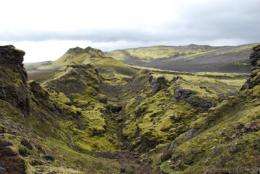Maybe Ben Franklin was wrong: A volcanic eruption, climate fluctuations and the frigid winter of 1783-84

The eruption of the Laki volcano in Iceland in 1783-84 set off a cascade of catastrophe, spewing sulfuric clouds into Europe and eventually around the world. Poisonous mists and a resulting famine from loss of crops and livestock killed thousands in Iceland, up to a quarter of the population. An estimated 23,000 people in Britain died from inhaling toxic fumes. Acid rain, heat, cold, drought and floods have been attributed to the eruption, which lasted from June until February.
But a new study says that for all of its ill effects, the Laki eruption probably was not the main culprit behind one of the coldest winters in hundreds of years, as many scientists — and contemporary observer Benjamin Franklin -- have speculated.
Instead, that unusually cold and snowy winter in western Europe and eastern North America may have been caused by the same climate fluctuations that led to the harsh winter of 2009-2010, according to a team of scientists from Lamont-Doherty Earth Observatory and the NASA Goddard Institute for Space Studies.
Their research was recently published in Geophysical Research Letters. The scientists looked at 600 years of tree-ring data to reconstruct the shifts in two of the main drivers of the Earth’s climate, the North Atlantic Oscillation and the El Niño-Southern Oscillation. They spliced onto that instrumental records from more recent years, and backed up the results with long instrumental, proxy and historical observations, said lead author Rosanne D’Arrigo of the Lamont Tree Ring Lab.
She says the group is talking about follow-up research looking at spacial patterns for past extreme event combinations of the different phases of the two climate oscillations.
When they finished their statistical analysis, the scientists concluded that the 1783-84 weather was most likely the result of a rare confluence: A warm tropical eastern Pacific Ocean -- El Niño -- combined with a strong negative pressure in the North Atlantic Ocean. The El Niño drives more moisture across North America, and the negative North Atlantic Oscillation drives cold Arctic air south over the East Coast and northwest Europe. The result: a rough winter.
One of the authors, Richard Seager, and colleagues at Lamont concluded in another paper last year that that’s exactly what happened in 2009-2010, as well. Ironically, despite the harsh winter in some areas, the global average temperature in 2009 made it one of the warmest years on record.
In the new paper, the researchers say they found that the combined El Niño and negative NAO in 2009-2010 were stronger than at any time since the 1400s. And through that time period the second strongest signals were in 1783-84.
The authors note that back in 1783-84, in the newly fledged United States, George Washington complained that the snow and ice kept him stranded in Mount Vernon between Christmas Eve and early March, and James Madison wrote from his home in Virginia about suffering through the worst winter in memory. Writing in 1784, Benjamin Franklin speculated that a persistent haze, perhaps from Icelandic volcanoes, could have blocked the sun sufficiently to cause the unusually cool summer of 1783.
Provided by Columbia University



















